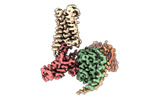登録情報 データベース : EMDB / ID : EMD-27967タイトル CryoEM structure of miniGo-coupled hM4Di in complex with DCZ CryoEM structure of miniGo-coupled hM4Di in complex with DCZ 複合体 : Gq-coupled hM3R complex複合体 : muscarinic acetylcholine receptor 4, miniGo protein, Guanine nucleotide-binding protein G(I)/G(S)/G(T) subunit beta-1, Guanine nucleotide-binding protein G(I)/G(S)/G(O) subunit gamma-2タンパク質・ペプチド : Muscarinic acetylcholine receptor M4タンパク質・ペプチド : miniGoタンパク質・ペプチド : Guanine nucleotide-binding protein G(I)/G(S)/G(T) subunit beta-1タンパク質・ペプチド : Guanine nucleotide-binding protein G(I)/G(S)/G(O) subunit gamma-2複合体 : Single-chain variable fragment scFv16リガンド : 11-(4-methylpiperazin-1-yl)-5H-dibenzo[b,e][1,4]diazepine / / / / / 機能・相同性 分子機能 ドメイン・相同性 構成要素
/ / / / / / / / / / / / / / / / / / / / / / / / / / / / / / / / / / / / / / / / / / / / / / / / / / / / / / / / / / / / / / / / / / / / / / / / / / / / / / / / / / / / / / / / / / / / / / / / / / / / / / / / / / / / / / / / / / / / / / / / / / / / / / / / / / / / / / / / / / / / / / / / / / / 生物種 Homo sapiens (ヒト) / Mus musculus (ハツカネズミ)手法 / / 解像度 : 2.7 Å Zhang S / Fay JF / Roth BL 資金援助 Organization Grant number 国 National Institutes of Health/National Institute of Diabetes and Digestive and Kidney Disease (NIH/NIDDK) U24DK1169195 National Institutes of Health/National Institute of Mental Health (NIH/NIMH) Psychoactive Drug Screening (PDSP)
ジャーナル : Nature / 年 : 2022タイトル : Molecular basis for selective activation of DREADD-based chemogenetics.著者 : Shicheng Zhang / Ryan H Gumpper / Xi-Ping Huang / Yongfeng Liu / Brian E Krumm / Can Cao / Jonathan F Fay / Bryan L Roth / 要旨 : Designer receptors exclusively activated by designer drugs (DREADDs) represent a powerful chemogenetic technology for the remote control of neuronal activity and cellular signalling. The muscarinic ... Designer receptors exclusively activated by designer drugs (DREADDs) represent a powerful chemogenetic technology for the remote control of neuronal activity and cellular signalling. The muscarinic receptor-based DREADDs are the most widely used chemogenetic tools in neuroscience research. The G-coupled DREADD (hM3Dq) is used to enhance neuronal activity, whereas the G-coupled DREADD (hM4Di) is utilized to inhibit neuronal activity. Here we report four DREADD-related cryogenic electron microscopy high-resolution structures: a hM3Dq-miniG complex and a hM4Di-miniG complex bound to deschloroclozapine; a hM3Dq-miniG complex bound to clozapine-N-oxide; and a hM3R-miniG complex bound to iperoxo. Complemented with mutagenesis, functional and computational simulation data, our structures reveal key details of the recognition of DREADD chemogenetic actuators and the molecular basis for activation. These findings should accelerate the structure-guided discovery of next-generation chemogenetic tools. 履歴 登録 2022年8月27日 - ヘッダ(付随情報) 公開 2022年11月30日 - マップ公開 2022年11月30日 - 更新 2025年5月14日 - 現状 2025年5月14日 処理サイト : RCSB / 状態 : 公開
すべて表示 表示を減らす
 データを開く
データを開く 基本情報
基本情報
 マップデータ
マップデータ 試料
試料 キーワード
キーワード 機能・相同性情報
機能・相同性情報 Homo sapiens (ヒト) /
Homo sapiens (ヒト) / 
 データ登録者
データ登録者 米国, 2件
米国, 2件  引用
引用 ジャーナル: Nature / 年: 2022
ジャーナル: Nature / 年: 2022
 構造の表示
構造の表示 ダウンロードとリンク
ダウンロードとリンク emd_27967.map.gz
emd_27967.map.gz EMDBマップデータ形式
EMDBマップデータ形式 emd-27967-v30.xml
emd-27967-v30.xml emd-27967.xml
emd-27967.xml EMDBヘッダ
EMDBヘッダ emd_27967_fsc.xml
emd_27967_fsc.xml FSCデータファイル
FSCデータファイル emd_27967.png
emd_27967.png emd-27967.cif.gz
emd-27967.cif.gz emd_27967_additional_1.map.gz
emd_27967_additional_1.map.gz emd_27967_half_map_1.map.gz
emd_27967_half_map_1.map.gz emd_27967_half_map_2.map.gz
emd_27967_half_map_2.map.gz http://ftp.pdbj.org/pub/emdb/structures/EMD-27967
http://ftp.pdbj.org/pub/emdb/structures/EMD-27967 ftp://ftp.pdbj.org/pub/emdb/structures/EMD-27967
ftp://ftp.pdbj.org/pub/emdb/structures/EMD-27967 emd_27967_validation.pdf.gz
emd_27967_validation.pdf.gz EMDB検証レポート
EMDB検証レポート emd_27967_full_validation.pdf.gz
emd_27967_full_validation.pdf.gz emd_27967_validation.xml.gz
emd_27967_validation.xml.gz emd_27967_validation.cif.gz
emd_27967_validation.cif.gz https://ftp.pdbj.org/pub/emdb/validation_reports/EMD-27967
https://ftp.pdbj.org/pub/emdb/validation_reports/EMD-27967 ftp://ftp.pdbj.org/pub/emdb/validation_reports/EMD-27967
ftp://ftp.pdbj.org/pub/emdb/validation_reports/EMD-27967 リンク
リンク EMDB (EBI/PDBe) /
EMDB (EBI/PDBe) /  EMDataResource
EMDataResource マップ
マップ ダウンロード / ファイル: emd_27967.map.gz / 形式: CCP4 / 大きさ: 91.1 MB / タイプ: IMAGE STORED AS FLOATING POINT NUMBER (4 BYTES)
ダウンロード / ファイル: emd_27967.map.gz / 形式: CCP4 / 大きさ: 91.1 MB / タイプ: IMAGE STORED AS FLOATING POINT NUMBER (4 BYTES) 試料の構成要素
試料の構成要素 Homo sapiens (ヒト)
Homo sapiens (ヒト)
 Homo sapiens (ヒト)
Homo sapiens (ヒト)
 Homo sapiens (ヒト)
Homo sapiens (ヒト)
 Homo sapiens (ヒト)
Homo sapiens (ヒト)
 Homo sapiens (ヒト)
Homo sapiens (ヒト)



 解析
解析 試料調製
試料調製 電子顕微鏡法
電子顕微鏡法 FIELD EMISSION GUN
FIELD EMISSION GUN
 ムービー
ムービー コントローラー
コントローラー



































 Z (Sec.)
Z (Sec.) Y (Row.)
Y (Row.) X (Col.)
X (Col.)














































